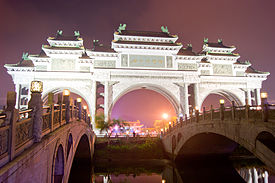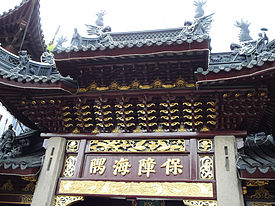- Paifang
-
Paifang 
Paifang in Shunfeng Park, Shunde Chinese 牌坊 Literal meaning memorial archway gate Transcriptions Hakka - Romanization pai2 fong1 Mandarin - Hanyu Pinyin páifāng - Bopomofo ㄆㄞˊ ㄈㄤ Min - Hokkien POJ pâi-hông Wu - Romanization ba平 faon平 Cantonese (Yue) - Jyutping paai4 fong1 Pailou Traditional Chinese 牌樓 Simplified Chinese 牌楼 Literal meaning memorial archway edifice Transcriptions Hakka - Romanization pai2 leu2 Mandarin - Hanyu Pinyin páilóu - Bopomofo ㄆㄞˊ .ㄌㄡ Min - Hokkien POJ pâi-lâu Wu - Romanization ba平 leu平 Cantonese (Yue) - Jyutping paai4 lau4 Paifang, also called pailou, is a traditional Chinese architectural gating style as an archway.
The word paifang (Chinese: 牌坊; pinyin: páifāng) originally was a collective term used to describe the top two levels of administrative division and subdivisions of ancient Chinese city. The largest division within a city in ancient China was a Fang (坊), equivalent to current day precinct. Each fang (坊) was enclosed by walls or fences, and the gates of these enclosure were shut and guarded every night. Each fang (坊) was further divided into several Pai (牌; literally "placard"), which is equivalent to current day (unincorporated) community. Each pai (牌), in turn, contained an area including several hutongs (alleyways). This system of urban administrative division and subdivision reached an elaborate level during Tang Dynasty, and was remained in the following dynasties. For example, during Ming Dynasty, Beijing was divided into a total of 36 fangs (坊). Originally, the word paifang (牌坊) was used as a term to describe the gate of a fang (坊) and the marker for an entrance of a building complex or a town; but by the Song Dynasty, a paifang had evolved into a purely decorative monument.
Contents
Origin
It is suggested that the Chinese paifang may have been derived from the torana temple-gate in ancient India,[1] though it has taken on traditional Chinese architecture characteristics such as multi-tiered roofs, various supporting posts, and archway-shapes of traditional gates and towers.[2][3] However, city gates are not particular to India.
During the Tang dynasty, it was called wutoumen (simplified Chinese: 乌头门; traditional Chinese: 烏頭門; literally "black top gate"), because the top of the two posts were painted black. Wutomen was reserved for officials of rank 6 or higher.
The construction of wutomen was standardized in Yingzao Fashi of the Song dynasty[4]. It consisted of two posts and a horizontal beam forming a frame and two doors. By the Ming and Qing dynasties, it was called pailou or paifang, and evolved into more elaborate structure with more posts and gates, with superstructural gable on top; the highest rank was five gate-six post-eleven gable pailou.
Style
Paifang comes in a number of forms. One form involves placing wooden pillars onto stone bases, and bound together with wooden beams. This type of paifang is always beautifully decorated, with the pillars usually painted in red, the beams decorated with intricate designs and Chinese calligraphy, and the roof covered with coloured tiles, complete with mythical beasts - just like a Chinese palace. Another form of paifang is in the form of true archways made of stone or bricks; the walls may be painted, or decorated with coloured tiles; the top of the archways are decorated like their wooden counterparts. Yet another form of paifang, built mainly on religious and burial grounds, consists of plain white stone pillars and beams, with neither roof tiles nor any coloured decoration, but feature elaborate carvings created by master masons.
Outside of China, the paifang has long been the symbol of Chinatowns. The largest of which is located in Chinatown, Liverpool, England.[5]
In the past, "Chastity Paifangs" were given to widows who remained unmarried till death, praising what was seen as loyalty to their deceased husbands.
Gallery
-
Paifang at the entrance to Chinatown in Boston, Massachusetts.
-
Paifang in Taipei.
-
Decorated paifang in Summer Palace.
-
Paifang at the National Palace Museum in Taipei, Taiwan.
-
Paifang of Wuhan University (1920).
-
Paifang in Xidi.
-
Pailou at Dunedin Chinese Garden, New Zealand.
See also
- Chinese architecture
- Chinese culture
- Chinatown
- Torii
- Hongsalmun
- Ruins of St. Paul's Cathedral, Macao
References
- ^ Joseph Needham, Science and Civilization in China, Vol 4 part 3, p137-138
- ^ Ronald G. Knapp (2000). China's old dwellings. University of Hawaii Press. p. 85. ISBN 0824822145.
- ^ Simon Foster, Jen Lin-Liu, Sharon Owyang, Sherisse Pham, Beth Reiber, Lee Wing-sze (2010). Frommer's China. Frommers. p. 435. ISBN 0470526580.
- ^ Li Jie, Yingzao Fashi, vol 6, Minor Woodwork I, section The Construction of Wutomen
- ^ http://www.visitliverpool.com/site/chinese-arch-p54681
Categories:- Chinese architecture
- Chinese words and phrases
- Types of gates
- East Asia stubs
-
Wikimedia Foundation. 2010.










